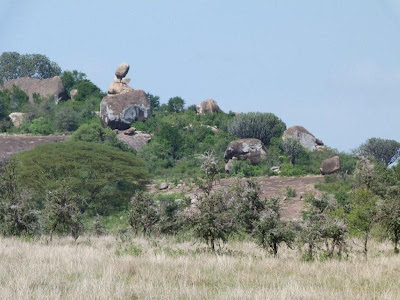 |
| Cross-section through a kopje in the process of formation from smooth, uninterrupted landscape at the top to typical kopje at bottom, following millions upon millions of years of erosion. |
As more time goes by, the overlying layers are gradually worn away, until eventually the lump of volcanic rock becomes exposed. Granite is a typical volcanic rock and is known for its hardness - the surrounding rocks (especially if they're sedimentary rocks like sandstones or mudstones) may be significantly softer and therefore as the erosion processes continue, they'll get worn down faster than the hard granites - they do erode, but not at the same rate as the softer rocks within which they are embeded. Eventually the hard granites too start to split, and in time may even form beautiful piles of stacked rocks along points of weakness in the harder rocks. This is all illustrated in the diagram on the right: at the top we start millions and millions of years ago with lots of layers of relatively soft rocks forming a smooth, uninterupted landscape. Below that an orange volcanic intrusion pushes up through the softer rocks, but cools underground into hard granite. As more time passes (moving down the sequence of figures) the top of the intrusion s eventually revealed at the surface (fig 4), still further erosion of both the soft rocks around the granite intrusion and the granite itself (but at a much slower rate) continues and a kopje forms. Eventually erosion of the granite may form the typical piled rocks (called tors) of the most impressive kopjes.
 |
| Moru Kopjes in Serengeti have some impressive tor features (piles of rock) |
As I say, all of this has happened over millions and millions of years: the kopjes of western Serengeti are themselves over 550million years old, and the surrunding rock through which they protrude far, far older still - over 1200 million years in much of Serengeti (these figures are all coming from here). The kopjes also don't need to be granite - many Serengeti kopjes are Gneiss, which is a metamophic rock (actually, often metamophosed granite!), the only important thing is that the kopje be derived from a rock that is substantially harder than the rocks around it.
And that's it really - nothing too complex at all!
No comments:
Post a Comment